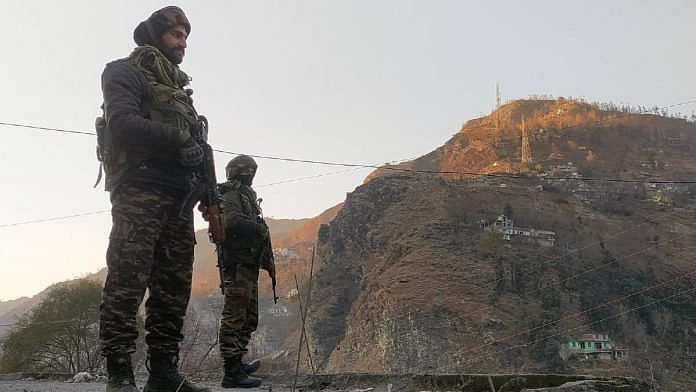There are significant but subtle changes happening in the militancy scenario of Jammu and Kashmir over the past couple of years. But there has not been much public discussion on this.
The shift is in modus operandi and geography. The centre of gravity has now moved south of the Pir Panjal, after two decades. And the changing pattern of militant actions suggests that the goal is shock value rather than just continuous pinpricks. These produce sharp ambushes with disproportionate psychological results.
The lesson for counter-terrorism strategy lies in the past — in how the Army mounted Operation Sarp Vinash.
The south of the Pir Panjal area was once an equally active militancy zone when excessive pressure in the Kashmir Valley forced Pakistan-based militant groups to set up bases in Poonch and Rajouri districts of Jammu division. Hill Kaka, where the militants had dug in during the early part of 2003, became the de facto headquarters of Terror Inc. The Army was then compelled to launch its biggest pincer movement in counter-insurgency operations after frequent attacks on security forces, along with exploitation of the local population. Named Op Sarp Vinash, with naturally deep colloquial connotations, the multi-formation action resulted in a large number of terrorists killed in both districts.
While there is little in common with the tactics adopted by the militants two decades ago, there is still a need to study the pattern established by them, and devise appropriate counter-strategies. In this aspect the militant groups, if there is more than one, and their handlers, of whom there are certainly many, have shown greater dynamism in instituting changes in tactics employed. The Army, though, has not shown a similar dynamism in forging new battlefield manoeuvres. As such, it has periodically been made to pay the ultimate price. There is, therefore, a need to borrow many leaves from Op Sarp Vinash.
Also read: Poonch ambush had unmistakable Pakistani hand. But here’s why Indian govt is downplaying it
A successful operation
The success of Op Sarp Vinash lay largely due to the fact that the complex multi-formation dual-service action was the culmination of a carefully planned encirclement operation that had a single strategic objective — elimination of militants from the sector. There was no scope or planning for esoteric objectives like securing political and administrative space or winning the hearts and minds. And elimination was completed with the deft use of Infantry, Special Forces, and armed helicopters. Manpower and technology were used in a simple and logical manner, which stemmed entirely from the intellectual and military acumen of then-formation commander.
A complex military operation was rendered simplistically by Maj Gen HS Lidder, General Officer Commanding of a counter-insurgency formation called Romeo Force. Bloodied as Commanding Officer in the steamy jungles of northern and eastern Sri Lanka, the GOC was among those who were bringing their practical experience onto formation level. Tactics remain pretty much the same even though terrain may vary in different counter-insurgency scenarios. Snow boots in Hill Kaka replaced the rubber sandals of Tamil Tigers, but militants remained dependent on similar logistics chains, and employed similar fire drills. Except that the Army didn’t play the same game.
Instead of the usual jungle bashing drills, the GOC Romeo Force gradually built up the numbers, tightening the noose as availability of troops kept increasing. Troops and local porters were suitably employed in creating ad hoc helipads and other logistics bases, which is most essential when it comes to siege tactics. Select ambush sites picked off any reinforcements that the militants hoped to bring in, or those hoping to escape their tickets to heaven had been erased. Local herdsmen and villagers pitched in, putting aside sectarian divisions. And then militant hideouts, caves or bunkers were picked out by helicopter fire or by deft Special Forces tactics.
Op Sarp Vinash succeeded in ushering in more than a decade of relative peace in the two affected districts. Yet it had its detractors among the civilian security establishment, who chaffed at the thought of militants being able to establish such elaborate firm bases. The number of those killed as well as the operational methods were derided. But that doesn’t detract from the fact that Op Sarp Vinash found operational success, and it yet doesn’t erase local memories of those who benefitted from that action. It is time now for the Army to dust off the Sarp Vinash files, and refresh lessons.
Also read: Poonch killing of Indian soldiers shows jihad will increase India-Pakistan war risk
The lesson stands today
The most important lesson is for the Army to determine the timing and tactics of its operations by its own accord and acumen, not by any other external considerations. Slow, deliberate and painstakingly prepared actions are far better than rushing troops for the sake of quick results and then paying the highest price as happened last May. Since then, the Army has been losing soldiers at an abnormally regular pace, from largely similar ambushes. And all within the districts of Rajouri, Poonch and parts of Reasi. The terrain isn’t easy, but then it wasn’t in 2003 either, with resources readily available.
Winter is a murderous time to launch operations in this area, but it is also when logistics are severely limited for militants, and their civilian overground workers. And no force can fight without logistics, as is clearly evident from the repeated airlift of weapons and armaments for the Israel Defence Forces, already the best equipped in the region. While 2024 doesn’t require a repeat of Op Sarp Vinash, since militant numbers are reportedly less than that period, mobilisation and encirclement will require similar planning. While circumstances change, militants rely on similar logistics albeit supporting new players, with better tactical skills.
Manvendra Singh is a Congress leader, Editor-in-Chief of Defence & Security Alert and Chairman, Soldier Welfare Advisory Committee, Rajasthan. He tweets @ManvendraJasol. Views are personal.
(Edited by Prashant)



